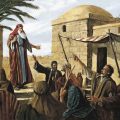Dear Gramps,
I have always had a hard time really understanding Mosiah 15:1-5. How do I explain those verses to someone and make it clear that it is not saying that the Savior and the Father are the same being? The wording is really confusing. Thank you so much for this great service!
Robyn, from New Jersey
Dear Robyn,
There are a couple of statements in these verses that might be confusing to those who do not fully understand the true nature of Deity. First we read that “God himself shall come down among the children of men, and shall redeem his people.” The Lord and Savior, Jesus Christ, is indeed a God. The word “God” in this context does not mean God, the Father, but God the Son. It is the Lord, Jesus Christ, that “shall redeem his people” through the merits of the great atoning sacrifice.
Secondly, in verse 2, the Savior is referred to as “being the Father and the Son.” We must remember that every father among men is both a father and a son, but that does not make a man and his father one person. We understand that the Savior is “the only begotten Son,” but in what sense is he the Father? The explanation given in the following verse three may not be perfectly clear, but let’s try to examine it. The Savior may be called the Father “because he was conceived by the power of God.” Having been conceived by the power of God he had the ability to take upon himself the sins of the world and to overcome death, thus becoming the Great Redeemer. As the Redeemer he becomes the “spiritual father” of all those who accept him as their Savior and live according to his commandments. This is clearly explained in Mosiah 5:7.
And now, because of the covenant which ye have made ye shall be called the children of Christ, his sons, and his daughters; for behold, this day he hath spiritually begotten you; for ye say that your hearts are changed through faith on his name; therefore, ye are born of him and have become his sons and his daughters.
Gramps







